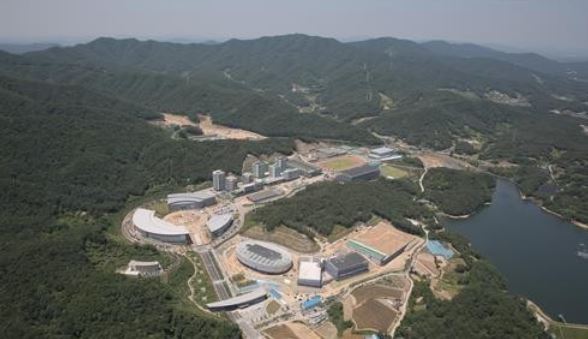JINCHEON -- A new training center for South Korea national team athletes officially opened Wednesday, signaling a fresh era in the country's sports history.
The Ministry of Culture, Sports and Tourism, and the Korean Sport & Olympic Committee hosted the opening ceremony of the National Training Center in Jincheon, North Chungcheong Province, at 3 p.m. More than 2,000 guests, including Prime Minister Lee Nak-yeon, KSOC President Lee Kee-heung, and former Olympic medalists, attended the event.
"We will open a new chapter in national team training by running the center with a future-oriented mind," Lee Kee-heung said. "The Jincheon center is going to be pivotal for South Korea to become an advanced sports country and we will make this a place where elite and recreational sports can co-exist and interact with one another."
The Jincheon center replaces the Taereung National Training Center in Seoul, which has been home to national athletes since 1966.
"If the Taereung center was a cradle for South Korean sports, the Jincheon center will be a base for its progress and development," Prime Minister Lee said. "National athletes' effort and tears will remain forever at the Taereung center and people will remember the place as long as they remember enjoyment and inspiration from the Olympic Games."
Before welcoming the new facility, former athletes like boxer Kim Kwang-sun, who won gold at the 1998 Summer Games, and judoka Kim Mi-jung, a 1992 Olympic gold medalist unveiled their stories about the old training ground at the ceremony.
The Ministry of Culture, Sports and Tourism, and the Korean Sport & Olympic Committee hosted the opening ceremony of the National Training Center in Jincheon, North Chungcheong Province, at 3 p.m. More than 2,000 guests, including Prime Minister Lee Nak-yeon, KSOC President Lee Kee-heung, and former Olympic medalists, attended the event.
"We will open a new chapter in national team training by running the center with a future-oriented mind," Lee Kee-heung said. "The Jincheon center is going to be pivotal for South Korea to become an advanced sports country and we will make this a place where elite and recreational sports can co-exist and interact with one another."
The Jincheon center replaces the Taereung National Training Center in Seoul, which has been home to national athletes since 1966.
"If the Taereung center was a cradle for South Korean sports, the Jincheon center will be a base for its progress and development," Prime Minister Lee said. "National athletes' effort and tears will remain forever at the Taereung center and people will remember the place as long as they remember enjoyment and inspiration from the Olympic Games."
Before welcoming the new facility, former athletes like boxer Kim Kwang-sun, who won gold at the 1998 Summer Games, and judoka Kim Mi-jung, a 1992 Olympic gold medalist unveiled their stories about the old training ground at the ceremony.

Following retired athletes, current stars like fencer Park Sang-young, the reigning Olympic gold medalist in the men's epee, and four-time Olympic shooting champion Jin Jong-oh spoke about their hopes for the new training center and commitments for the upcoming Olympic Games. Then all participants sang "Hand in Hand," the official song of the 1988 Summer Olympics in Seoul, to celebrate the birth of the Jincheon center.
South Korea finalized its plan of building the Jincheon training base in 2004, but construction work actually began in February 2009 with a budget of 513 billion won ($450 million).
The Jincheon center, located some 90 kilometers south of Seoul, is about three times larger than the Taereung center. On 1.59 million square meters of land, there are 21 training facilities and eight buildings for lodging with 823 rooms. The Taereung center has 12 training venues and three buildings for lodging with 358 rooms on 310,969 square meters.
Among newly built facilities are a baseball field, a clay shooting range, a rugby stadium, a velodrome and venues for squash and canoeing.
The Jincheon base will also be able to accommodate 1,150 athletes in 35 sports at once, compared with 450 athletes in 12 sports that the Taereung center can hold. The new training site also has a medical center and a sports science center filled with high-tech equipment.
The KSOC said it will start moving various training gear and equipment from Taereung to Jincheon between Oct. 20 and Nov. 30.
With the opening of the new training base, the fate of the Taereung center has yet to be determined.
Although winter sports athletes, especially speed skaters and figure skaters, will still be training in Taereung for the 2018 PyeongChang Winter Olympics since the Jincheon center currently doesn't have a long track, short-track speed skaters and ice hockey players will move to the Jincheon center.
The KSOC is currently working to register the Taereung center as a cultural heritage site in order to preserve the venue's history and legacy. The national Olympic body recently reapplied to the Cultural Heritage Administration for the training center's cultural heritage selection after improving its paperwork.
After the United Nations Educational, Scientific and Cultural Organization designated royal tombs from the Joseon Dynasty (1392-1910) as World Heritage sites in 2009 and recommended the preservation of the areas surrounding them, the government had planned to demolish the Taereung center, which is located between Taereung, the tomb of Queen Munjeong, and Gangneung, the tomb of King Myeongjong and his consort Queen Insun. (Yonhap)


















![[KH Explains] Hyundai's full hybrid edge to pay off amid slow transition to pure EVs](http://res.heraldm.com/phpwas/restmb_idxmake.php?idx=652&simg=/content/image/2024/04/18/20240418050645_0.jpg&u=20240418181020)

![[Today’s K-pop] Zico drops snippet of collaboration with Jennie](http://res.heraldm.com/phpwas/restmb_idxmake.php?idx=642&simg=/content/image/2024/04/18/20240418050702_0.jpg&u=)